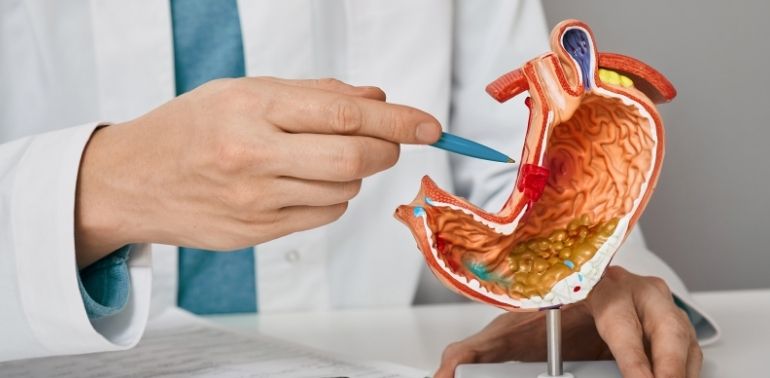
Treatment of GI Bleeding:
Gastrointestinal (GI) bleeding is a medical emergency that requires prompt diagnosis and treatment. It refers to any form of bleeding within the digestive tract, which can occur in the esophagus, stomach, small intestine, large intestine, rectum, or anus. GI bleeding can range from mild to severe, and depending on the source and cause, treatment can vary. Early intervention is critical in managing GI bleeding to prevent complications like anemia, shock, or organ failure.
Here's a guide to understanding the treatment options for GI bleeding:
Understanding GI Bleeding
GI bleeding can be classified into two types:
- Upper GI Bleeding: Bleeding that originates from the esophagus, stomach, or duodenum (the first part of the small intestine).
- Lower GI Bleeding: Bleeding that occurs in the small intestine, large intestine (colon), rectum, or anus.
Symptoms of GI bleeding include:
- Vomiting blood (hematemesis) or coffee-ground-like vomit
- Black, tarry stools (melena), which indicates blood has been in the digestive tract for a longer period
- Bright red blood in stools (hematochezia), often associated with lower GI bleeding
- Weakness, dizziness, and fatigue (from blood loss)
- Abdominal pain or discomfort
If you notice any of these symptoms, seek medical attention immediately.
Causes of GI Bleeding
The causes of GI bleeding can be divided into common and serious conditions:
Upper GI Bleeding Causes:
- Peptic Ulcers: Open sores in the stomach lining or duodenum that can bleed.
- Esophageal Varices: Swollen blood vessels in the esophagus, often due to liver cirrhosis.
- Gastritis or Esophagitis: Inflammation of the stomach or esophagus.
- Mallory-Weiss Tears: Tears in the mucosa of the esophagus, often caused by vomiting.
- Gastric Cancer: Tumors in the stomach can lead to bleeding.
Lower GI Bleeding Causes:
- Hemorrhoids: Swollen veins in the rectum or anus.
- Diverticulosis: Small pouches in the colon that can bleed.
- Colorectal Cancer: Tumors in the colon or rectum.
- Inflammatory Bowel Disease (IBD): Includes Crohn's disease and ulcerative colitis.
- Angiodysplasia: Abnormal blood vessels in the colon that can bleed.
Diagnosing GI Bleeding
To determine the source and severity of GI bleeding, several diagnostic tests may be used:
- Physical Examination: Initial assessment of vital signs, abdominal tenderness, and any signs of shock.
- Blood Tests: To check for anemia (low blood count), electrolyte imbalances, and liver function.
- Endoscopy: Upper GI bleeding is often diagnosed using an upper endoscopy (esophagogastroduodenoscopy or EGD) to visualize the esophagus, stomach, and duodenum. A colonoscopy is used for lower GI bleeding.
- Imaging: If the bleeding source is unclear, CT scans, angiography, or a tagged red blood cell scan may be used to locate the source of bleeding.
Treatment Options for GI Bleeding
The treatment of GI bleeding focuses on stabilizing the patient, identifying the source of the bleeding, and then stopping the bleeding. Depending on the severity and underlying cause, treatment may include medical management, endoscopic procedures, or surgery.
1. Initial Stabilization
The first priority in treating GI bleeding is to stabilize the patient:
- Intravenous Fluids (IV): To replace lost blood volume and maintain blood pressure.
- Blood Transfusions: If there is significant blood loss or anemia, transfusions may be necessary.
- Medications: Proton pump inhibitors (PPIs) are commonly used in cases of upper GI bleeding, particularly for peptic ulcers or gastritis, to reduce stomach acid and promote healing.
2. Endoscopic Treatment
Once the patient is stabilized, an endoscopy may be used not only for diagnosis but also for treatment:
-
Endoscopic Hemostasis: If the source of bleeding is identified during endoscopy (e.g., an ulcer or varices), various techniques may be used to control the bleeding:
- Injection Therapy: Epinephrine or sclerosing agents are injected to constrict blood vessels.
- Thermal Coagulation: Heat is applied to cauterize bleeding vessels.
- Hemoclips or Bands: Mechanical devices that are used to clamp or band bleeding vessels or varices.
3. Medications
Depending on the underlying cause of the bleeding, medications may be used to reduce or stop bleeding:
- Proton Pump Inhibitors (PPIs): These drugs reduce stomach acid and help heal peptic ulcers or gastritis.
- Antibiotics: If bleeding is related to an infection or in cases of cirrhosis and variceal bleeding, antibiotics may be prescribed to prevent infections.
- Vasopressors: In cases of esophageal varices or portal hypertension, medications like octreotide can constrict blood vessels to control bleeding.
4. Interventional Radiology
In some cases where endoscopic treatment is unsuccessful, interventional radiology may be used:
- Angiography and Embolization: If a bleeding vessel is identified, a catheter can be inserted into the blood vessel to deliver embolizing agents (e.g., coils or glue) to stop the bleeding.
5. Surgical Treatment
If bleeding cannot be controlled by endoscopic or interventional techniques, surgery may be required:
- Surgical Repair of Ulcers or Diverticulosis: If a specific lesion or area of the GI tract is identified as the source of bleeding, surgery may be necessary to remove the damaged tissue or repair the blood vessels.
- Colectomy: In cases of significant bleeding from conditions like colorectal cancer or diverticular disease, part of the colon may need to be removed.
6. Treatment for Specific Conditions
- For Esophageal Varices: The use of medications (e.g., beta-blockers) to reduce portal pressure, along with endoscopic banding or sclerotherapy, is common. In severe cases, a transjugular intrahepatic portosystemic shunt (TIPS) procedure may be used to bypass the liver's portal vein system.
- For Hemorrhoids: Conservative treatments, such as dietary changes, topical medications, or rubber band ligation, may be used. Severe cases may require hemorrhoidectomy.

